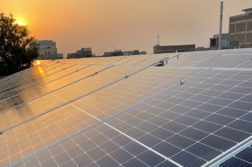Despite the Rudd Government’s decision not to take its ETS to the next election, all big businesses have known that the move into a carbon-constrained world isn’t an "if", it’s a "when". Paradoxically, right now it’s not having to pay for the cost of their carbon pollution which is causing many businesses the most problem. That’s because it’s the lack of certainty about what policy is going to come in, and when, which is creating havoc for their long-term investment strategies.
As Declan Kuch argues elsewhere on newmatilda.com today, now is the time to have another really close look at the policy options. But while Kuch proposes a range of ways to improve the ETS framework, there is serious doubt over whether the ETS was ever the right policy in the first place.
We need to take this opportunity to develop a much simpler, more transparent carbon pollution reduction policy, one that would provide a dependable income stream to invest in retraining people for jobs in new lower-emissions industries, and for carefully targeted rebates to low-income households. That policy is a carbon tax.
How would a carbon tax work? Like emissions trading, a carbon tax is all about introducing a price on carbon pollution. It works by adding a tax on the price of coal, gas and oil, set at a rate based on the carbon intensity of the fuel. For instance, the carbon tax on electricity generated from burning natural gas would be only half as much as from burning black coal, because burning gas produces only half the emissions. The added cost of using fossil fuels would inevitably be passed on, meaning price rises for things including petrol, electricity and groceries.
For consumers, the prospect of even the smallest price rise is never welcome. But the fact is that, unless you believe that climate change isn’t a problem at all, it’s inevitable that we will eventually have to address these hidden costs. That means the real question is how to make that economic change fair and effective. A key advantage of a carbon tax is that it’s a more transparent solution than emissions trading because it’s easier to see exactly what tax everyone is paying.
As well, because a carbon tax would apply right across the economy, it would also drive change in critical areas such as energy efficiency and better buildings, which we know can deliver the biggest, quickest, most cost-effective reductions in our emissions now. Doing that would begin the transition away from outdated, unnecessarily energy-intensive ways of doing things. It’s the catalyst we’ve been waiting for to get Australia moving towards being a low-carbon economy.
For business, a tax offers more certainty and control over their costs, enabling them to plan ahead instead of not knowing whether the price of permits to pollute under an emissions trading scheme might spike up or down, as has happened in the EU. As staff from the International Monetary Fund wrote in late 2009, that kind of unstable carbon price is still slowing down investment in renewable energy. And that’s exactly what we’ve recently seen in Australia with several high profile renewable energy projects being cancelled or put on hold.
There’s nothing new or radical about the idea of carbon taxes. Over the past 20 years, around half a dozen European countries, including Denmark, Finland, Britain and Ireland, have brought in various types of levies or carbon taxes. More recently, other countries that have either given in-principle backing to a carbon tax, or else are in the process of bringing one in, include China, Japan and Indonesia. One of the first to act was Sweden, which introduced a carbon tax in 1991 that has since been gradually increased. That economic reform started a shift in how Swedes did business and heated their homes, helping them achieve something that many said was impossible: shrinking the nation’s carbon footprint without shrinking the economy.
In stark contrast with most other countries, Sweden’s greenhouse gas emissions have fallen by more than 7 per cent below 1990 levels, while its Gross Domestic Product has grown by more than 40 per cent. Continuing to push for further improvements, in 2007 the Swedish parliament decided to modify the tax to reduce emissions by another 4 per cent, at the same time as integrating with the EU trading scheme. The Swedish environment minister, Andreas Carlgren, has highlighted just how successful the tax has been, noting that, without it, the country’s emissions would have been 20 per cent higher today.
But few policies are completely problem-free, and it’s fair to ask what the potential problems of a carbon tax might be. A carbon tax is certainly not foolproof. Like emissions trading, a tax can be badly undermined in all sorts of ways. For example, if the tax is set too low, or the industry and household compensation for its introduction is too high, there would similarly be little incentive for anyone to change. Another common concern is that a carbon tax could hurt business and affect jobs.
One solution with broad support is to use some of the money raised to reduce other taxes, such as income tax and payroll tax. That means that there is still a price being charged for greenhouse gas emissions, sending an economic signal to drive change, but in the meantime the costs of employing people would actually fall. For all the exaggerated claims about paying $100 for a steak, the difference in most Australians’ household bills before and after introducing either a carbon tax or an emissions trading scheme would be far less than the scaremongering suggests. The only householders who are genuinely expected to need compensation to avoid disproportionate price hikes are a relatively small number of low-income people, or people living in areas with high transport costs.
Crucially, in many cases, price increases for consumers and businesses can be avoided entirely by changing wasteful habits, as practical energy-saving programs here in Australia, California and elsewhere have proven time and again. Often it can be done with the simplest solutions, such as installing solar hot water systems, planting trees to provide external shade, and changing personal or work practices to make more productive use of energy, water and other resources.
As for how to practically bring in a carbon tax, a recent study for the conservative Centre for Independent Studies outlined one way to get started, with a tax of $30 per tonne of greenhouse gas emissions on energy use alone raising around $13 billion a year. Those funds could be used to support emissions-saving projects, from small-scale community and business grants through to investing in sorely needed public transport infrastructure.
Compared with an ETS, a tax is a simpler, more effective, faster solution for cutting emissions. That’s why so many people and major financial institutions — from renowned economists like Jeffrey Sachs and Nobel laureate Joseph Stiglitz to world-leading scientists like NASA’s James Hansen — all back a tax over trading.
While selling any new tax is hard, even recent history shows it’s far from impossible. Politicians who are convinced that it’s the right thing to do — which, for all his faults, John Howard was with the GST — have braved opposition to make their case and succeeded. Similarly, if politicians were convinced that Australians really wanted fast, effective cuts in our emissions, then more of them would be making the case for a carbon tax.
This is an edited extract from Screw Light Bulbs: Smarter ways to save Australians time and money (UWA Publishing).
Donate To New Matilda
New Matilda is a small, independent media outlet. We survive through reader contributions, and never losing a lawsuit. If you got something from this article, giving something back helps us to continue speaking truth to power. Every little bit counts.



